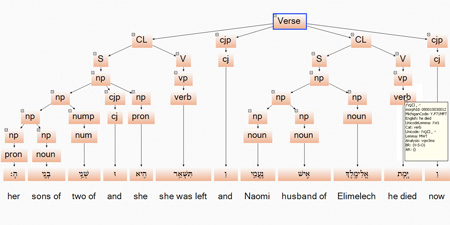ProjectsThe Westminster Leningrad Codex Westminster Hebrew MorphologyThe Groves-Wheeler Westminster Hebrew Morphology (Senior editor: Professor Lowery; Editor: Steve Salisbury). With seed funding from the Packard Humanities Institute (PHI), a team of Westminster scholars under the direction of Professor Groves began in 1987 to perfect a computerized version of the morphological analysis of the Hebrew text. We say perfect, because the basis for the text was a machine-produced analysis done by Richard Whitaker (Claremont, Princeton Seminary), who used the IBYCUS system to develop a parser that provided a trial parsing for about 95 percent of the words of the Hebrew Bible. While much editing was required, this initial analysis provided an excellent beginning database from which to build the database that exists today. The first version of the morphology was released in the summer of 1991. The second version, with significant corrections supplied by users, was released in 1994. The third version, which added homonyms and normalized the lemmatization to Kohler Baumgartner III, came out in 1998. The combination of the machine-readable version of the text and analysis provides a significant tool for Hebrew study for students at every level of interest and ability in Hebrew. The database is now referred to as the Groves-Wheeler Westminster Hebrew Morphology and stands at version 4.8 (July, 2007). Significant contributions have been made by Professor Dale Wheeler (Multnomah Bible College), Professor Todd Beall (Capital Bible Seminary), Professor Eep Talstra (the Werkgroep Informatica, the Free University, Amsterdam), and Ferdinand Poswick (the Centre Informatique et Bible, Maredsous, Belgium). Under the direction of Professor Lowery, enhancements and corrections are ongoing. The Westminster Hebrew Morphology has been incorporated into many Bible software products. Among them are: Accordance by Oak Tree Software (Mac); BART by SIL/Wycliffe (Win); BibleWorks by Hermeneutika (Win); Logos by Logos Research Systems (Win); and WordSearch by iExalt Electronic Publishing (Win). Many of these products are available at a discount from Westminster Bookstore. For information about licensing the Westminster Hebrew Morphology for use in software pages or products, contact Professor Lowery. Westminster Hebrew SyntaxWith the completion of the Westminster Hebrew Morphology, the next logical step in linguistic analysis of the Hebrew Bible is syntax. Each separate sentence in the Hebrew Bible is identified and separated into its component parts (constituent analysis). In order to maximize consistency and objectivity of analysis, the computer is taught to do the analysis by giving it a complex set of grammar rules to use. The resulting database can be used for many different purposes, including Bible translation. For this reason, the Groves Center is partnering with the Asia Bible Society to build a new generation of translator tool, where the computer actually proposes translations to the translator. An essential element of this tool is a “map” between biblical Hebrew syntactic structures and the syntactic structures of the target language – in this case, Mandarin Chinese. This project is entering its final phases (October, 2007). 
|







 This text began as an electronic transcription by Richard Whitaker (Princeton Seminary, New Jersey) and H. van Parunak (then at the University of Michigan, Ann Arbor) of the 1983 printed edition of Biblia Hebraica Stuttgartensia (BHS). It was continued with the cooperation of Robert Kraft (University of Pennsylvania) and Emmanuel Tov (Hebrew University, Jerusalem), and completed by Prof. Alan Groves. The transcription was called the Michigan-Claremont-Westminster Electronic Hebrew Bible and was archived at the Oxford Text Archive (OTA) in 1987. It has been variously known as the “CCAT” or “eBHS” text. Since that time, the text has been modified in many hundreds of places to conform to the photo-facsimile of the Leningrad Codex, Firkovich B19A, residing at the Russian National Library, St. Petersburg; hence the change of name. The Groves Center has continued to scrutinize and correct this electronic text as a part of its continuing work of building morphology and syntax databases of the Hebrew Bible, since correct linguistic analysis requires an accurate text.
This text began as an electronic transcription by Richard Whitaker (Princeton Seminary, New Jersey) and H. van Parunak (then at the University of Michigan, Ann Arbor) of the 1983 printed edition of Biblia Hebraica Stuttgartensia (BHS). It was continued with the cooperation of Robert Kraft (University of Pennsylvania) and Emmanuel Tov (Hebrew University, Jerusalem), and completed by Prof. Alan Groves. The transcription was called the Michigan-Claremont-Westminster Electronic Hebrew Bible and was archived at the Oxford Text Archive (OTA) in 1987. It has been variously known as the “CCAT” or “eBHS” text. Since that time, the text has been modified in many hundreds of places to conform to the photo-facsimile of the Leningrad Codex, Firkovich B19A, residing at the Russian National Library, St. Petersburg; hence the change of name. The Groves Center has continued to scrutinize and correct this electronic text as a part of its continuing work of building morphology and syntax databases of the Hebrew Bible, since correct linguistic analysis requires an accurate text.